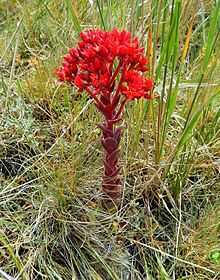|
Rosularia
 Rosularia is a small genus of the family Crassulaceae. It includes about 28-35 species from Europe, the Himalayas, and northern Africa. TaxonomyRosularia was originally described by De Candolle (1828) as a section of the genus Umbilicus,[2] and raised to the level of genus by Stapf (1923)[3] Thus the genus bears the botanical authority (DC) Stapf of both authors.[1] In 1930 Berger included it in family Crassulaceae subfamily Sedoideae, as one of 9 genera.[4][5] He further divided it into two sections (Eu-Rosularia and Ornithogalopsis) and further series,[6] transferring some species of Sedum to it. Since then a number of species have been transferred in and out of the genus, including S. sempervivoides, which at one stage was placed in Prometheum.[5] The genus Sempervivella was submerged in Rosularia.[6] The genus is now placed within the Leucosedum clade, tribe Sedeae, subfamily Sempervivoideae of the Crassulaceae, but is embedded within Sedum paraphyletically.[7][1][8] SpeciesRosularia contains about 28 species. The following species and subspecies were accepted by The Plant List (2013):[9][10]
Distribution and habitatRosularia is found in arid and semi-arid regions from N. Africa (Morocco, Ethiopia), through the eastern Mediterranean to Central Asia (north of Tien Shan and east of W Himalaya), including Pakistan.[6][5] EcologyRosularia is an important larval host for the Central Asian butterfly Parnassius apollonius.[12] UsesA number of species are cultivated as ornamental garden plants, and have been used in traditional medicine.[5] References
Bibliography
Wikispecies has information related to Rosularia. Wikimedia Commons has media related to Rosularia.
|
||||||||||||||||||||||||||||||||||
